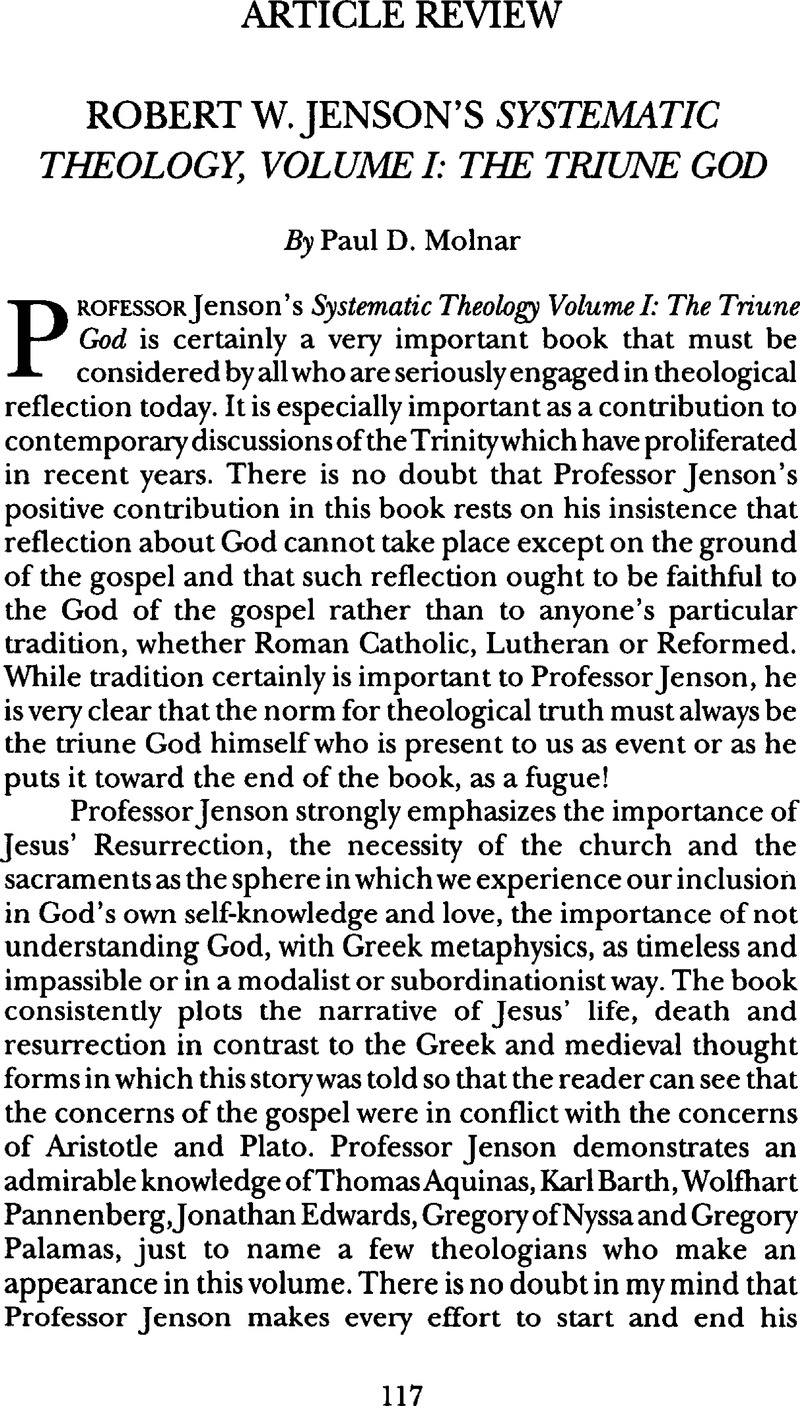No CrossRef data available.
Published online by Cambridge University Press: 30 January 2009

1 Jenson, Robert W., God According to the Gospel: The Triune Identity (hereafter: The Triune Identity) (Philadelphia: Fortress Press, 1982), p. 139.Google Scholar
2 See my Toward a Contemporary Doctrine of the Immanent Trinity: Karl Barth and the Present Discussion, in Scottish Journal of Theology.Vol. 49, No. 3, 1996, pp. 337f. and 345ff.Google Scholar
3 Jenson, Robert W., Systematic Theology Volume I: The Triune God (hereafter: STI) (New York: Oxford University Press, 1997), p. 144.Google Scholar
4 Torrance, Thomas F., Theology in Reconciliation, (London: Geoffrey Chapman, 1975), pp. 151ff. and 2OlffGoogle Scholar. follows Athanasius and Cyril of Alexandria and presents a positive understanding of Christ's vicarious humanity that neither falls into Apollinarian substitution of divinity for his humanity nor into Nestorian separation. Thus, ‘since the Son of God did not just come into man but came as man, yet without ceasing to be God, the same subject in the Incarnation occupies two roles that are not just two roles or modes but real natures’, p. 155. See also Torrance, T. F., The Christian Doctrine of God, One Being Three Persons (Edinburgh: T & T Clark, 1996), pp. 40–41.Google Scholar
5 STI, p. 191.
6 Barth, Karl, Church Dogmatics, 4 vols. in 13 pts. (hereafter: CD.) Vol. 1, pt. 1: The Doctrine of the Word of God, trans, by Bromiley, G. W., ed. by G. W. Bromiley and T. F. Torrance (Edinburgh: T. &T. Clark, 1975), p. 323.Google Scholar
7 C.D. 4, 2, pp. 63ff.
8 C.D. 1, 1, p. 323.
9 C.D. 3, 1, p. 54. Cf. CD. 4, 1, p. 52. Cf. also CD. 1, 2, pp. 168ff. and CD. 3, 2, pp. 65f., pp. 147f. and The Göttingen Dogmatics, vol. 1, ed. Reiffen, , trans. Bromiley, (Grand Rapids: Wm. B. Eerdmans, 1991), p. 160Google Scholar where Barth wrote: ‘The Son is both logos ensarkos and bgos asarkos. Do we not have to say this afresh and for the first time truly the moment we speak about the union of God and man in revelation lest we forget that we stand here before the miracle of God? Can we ever have said it enough?’
10 Cf. The Triune Identity, pp. 138–41. Professor Jenson believes such a concept prevents the procession of the Son from being the same as Jesus' mission. And indeed it does; precisely in order to prevent God's eternal freedom from being confused with his freedom for us. This is not to suggest a separation of jesus' humanity and divinity but to say that, unless his mission is seen against the background of his being in se before the world was, then his deity will be equated with or seen as the outcome of history. Professor Jenson, following Wolfhart Pannenberg, sees it this way. Thus ‘the Trinity is simply the Father and the man Jesus and their Spirit as the Spirit of the believing community’, (p. 141). What happened to the eternal Trinity which preexisted, exists now and is also future? This Trinity is banished into a future: ‘This “economic”Trinity is eschatologically God “himself,”an “immanent”Trinity’, (ibid.). Hence Professor Jenson substitutes Jesus' resurrection for God's ousia (p. 168) and argues that “The divine ousia is no longer our first concern. It is the work, the creative event done as Jesus' life, death, resurrection …’ (p. 113); here historical events displace God's eternal being and action. This is the major problem that follows Rahner's axiom of identity with its ‘vice versa’.
11 CD. 1, 1, p. 420. Cf. also ibid., pp. 416ff.
12 STI,.p. 141.
13 The Triune Identity, p. 106.
14 ST1, p. 221.
15 Ibid. p. 77.
16 Ibid., p. 140.
17 CD. 4, 1, p. 66.
18 STI, p. 142.
19 Ibid., p. 143.
20 Ibid., p. 171.
21 Ibid., p. 199.
22 Ibid., p. 219.
23 Ibid., p. 66. By contrast, see CD. 1, 2, p. 38 where Barth writes: ‘He who the third day rose from the dead was no less true God in the manger than on the cross.’
24 Ibid., p. 174.
25 Ibid., p. 14.
26 Ibid., p. 16.
27 The Triune Identity, p. 168.
28 STI, pp. 196–201.
29 Ibid., p. 201.
30 Ibid., p. 204.
31 Ibid., p. 205.
32 Ibid., p. 206.
33 Cf. CD. 3, 2, pp. 327, 330, 448, and Lk. 24:36f. and Jn. 20:24.
34 Torrance, Thomas F.The Tnnitanan Faith (Edinburgh: T.&T. Clark, 1988), p. 299.Google Scholar
35 STIp. 229.
36 Ibid., p. 199.
37 CD. 3, 2, p. 449.
38 STIpp. 94ff.
39 Ibid., p. 171.
40 Ibid., p. 214.
41 Ibid., p. 216.
42 ibid.
43 Cf. Gregory of Nyssa, Against Eunomius Book I, §42 in Select Writings and Letters of Gregory, Bishop of Nyssa, Translated by Moore, William and Wilson, Henry, Nicene and Post-Nicene Fathers of The Christian Church (Grand Rapids, Michigan: Wm. B. Eerdmans Publishing Company, 1988), p. 98.Google Scholar
44 S7Y, p. 217.
45 Cf. E.g., ibid., p. 223.
46 Ibid., p. 217.
47 Ibid., p. 218.
48 Ibid., p. 219.
49 Ibid., p. 220.